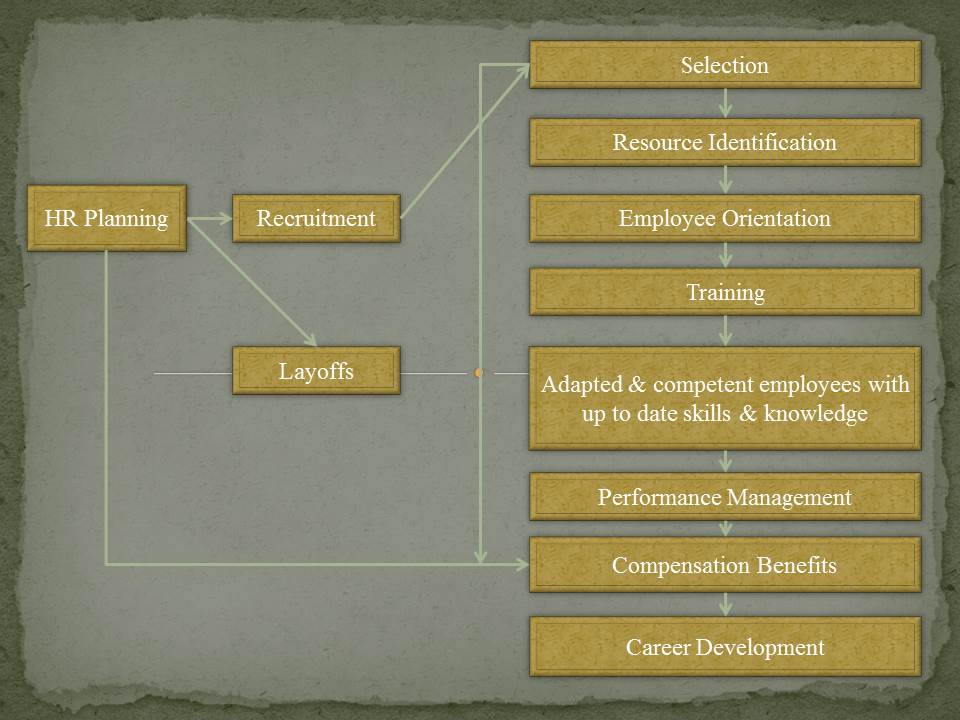Management Process
Management process is the systematic combination of five basic functions, namely:
• Planning
• Organizing
• Staffing
• Leading
• Controlling
Human Resource Management (HRM)
HRM is a name of Policies and Practices involving people or human resource aspects of a management position, including screening, recruitment, appraising, and rewarding. In other words, HRM is the process to select, incorporate orientation, develop, and retain the quality human resource. The function performs to support to use people in the most effecting way in any organization to achieve individual and organizational goals is called Human Resource Management.
Manager’s Job – The Most Personnel Aspects
• Conducting job analyses (determining the nature of the job of each employee)
• Planning labor needs
• Communicating (interviewing, counseling, disciplining)
• Selecting job candidates
• Recruiting job candidates
• Orienting and training new employees
• Managing wages and salaries (compensating employees)
• Providing incentives and benefits
• Appraising performance
• Training and developing managers
• Building employee commitment
Manager’s Job – Personnel Mistakes
• Wastage of time with useless interviews
• Hiring the wrong person for the job
• Experiencing high turnover
• Employees not doing their best
• Employees of the company in court because of discriminatory actions
• Employees think their salaries are unfair and inequitable relative to others in the organization
• Allowing a lack of training to undermine HR’s effectiveness
• Committing any unfair labor practices
Core Functions of HR
• Human Resource Planning
• Recruitment and selection
• Performance Management
• Compensation and Benefits
• Employee Assistance Program
• Organization and Job design
• Training and Development
• Organization Development
• Employee Relations and Retention Strategies
• Human Resource Planning
Basic Concepts of HR
The bottom line of managing HR functions is to get results. The overall purpose of the HR concept is to create values by engaging employees in productive activities that can positively impact employee behaviors to achieve the company’s strategic goals.
Authority of HR
Authority is the right to make decisions, direct work to others, and give orders. These can be further categories as:
• Implied authority – This is the authority which is used by an HR manager by good point of others’ knowledge that he or she has access to top management.
• Line authority – This is the authority put forth by an HR manager to direct the activities of the people in his or her own department and in service areas.
Line and Staff Aspects of HRM
• Line manager: A manager who is authorized to direct the work of subordinates and is responsible for accomplishing the organization’s tasks.
• Staff manager: A manager who assists and advises line managers.
Responsibilities HR Line Manager
• Placement the right person on the right job
• Orientation (Starting new employees in the organization)
• Training arrangements for jobs new to employees
• Improving the job performance of each employee
• Gaining creative cooperation
• Developing smooth working relationships
• Interpreting the firm’s policies and procedures
• Controlling costs i.e. wages, accidents, environment, etc.
• Developing the abilities of each person
• Creating and maintaining moral department morale
• Creating a healthy environment to Protect employees’ health and physical condition
Functions of the HR Manager
• Line Function:
o The manager HR directs the activities to his or her own department’s staff and in related service areas.
• A Coordinative Function:
o HR managers also coordinate personnel activities, a duty often referred to as functional control.
o The right arm of the top executive.
• Staff Functions:
o Assisting and advising line managers is the heart of the HR manager’s job.
o How to treat employees etc.
Employee Advocacy
• Defining clearly that how management should treat employees.
• Making sure that all employees should have the mechanisms required to contest unfair practices.
• Representing the interests of employees within the framework of HR primary obligation to senior management.
For reading,
click at Human Resource Management – Part 2
Also, visit Human Resource Management – Part 3
